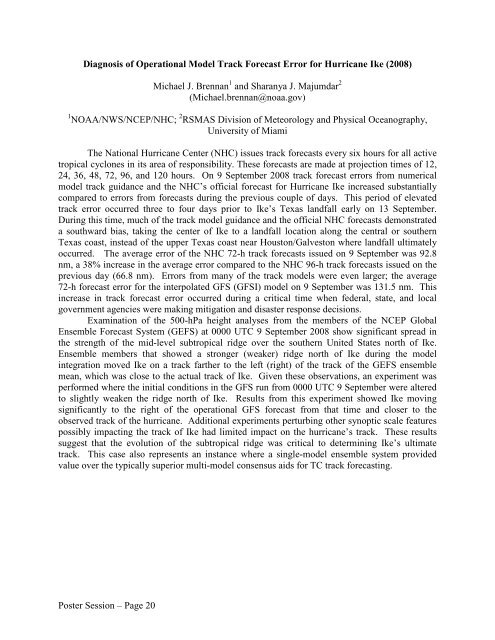65th IHC Booklet/Program (pdf - 4.9MB) - Office of the Federal ...
65th IHC Booklet/Program (pdf - 4.9MB) - Office of the Federal ...
65th IHC Booklet/Program (pdf - 4.9MB) - Office of the Federal ...
Create successful ePaper yourself
Turn your PDF publications into a flip-book with our unique Google optimized e-Paper software.
Diagnosis <strong>of</strong> Operational Model Track Forecast Error for Hurricane Ike (2008)<br />
Michael J. Brennan 1 and Sharanya J. Majumdar 2<br />
(Michael.brennan@noaa.gov)<br />
1 NOAA/NWS/NCEP/NHC; 2 RSMAS Division <strong>of</strong> Meteorology and Physical Oceanography,<br />
University <strong>of</strong> Miami<br />
The National Hurricane Center (NHC) issues track forecasts every six hours for all active<br />
tropical cyclones in its area <strong>of</strong> responsibility. These forecasts are made at projection times <strong>of</strong> 12,<br />
24, 36, 48, 72, 96, and 120 hours. On 9 September 2008 track forecast errors from numerical<br />
model track guidance and <strong>the</strong> NHC’s <strong>of</strong>ficial forecast for Hurricane Ike increased substantially<br />
compared to errors from forecasts during <strong>the</strong> previous couple <strong>of</strong> days. This period <strong>of</strong> elevated<br />
track error occurred three to four days prior to Ike’s Texas landfall early on 13 September.<br />
During this time, much <strong>of</strong> <strong>the</strong> track model guidance and <strong>the</strong> <strong>of</strong>ficial NHC forecasts demonstrated<br />
a southward bias, taking <strong>the</strong> center <strong>of</strong> Ike to a landfall location along <strong>the</strong> central or sou<strong>the</strong>rn<br />
Texas coast, instead <strong>of</strong> <strong>the</strong> upper Texas coast near Houston/Galveston where landfall ultimately<br />
occurred. The average error <strong>of</strong> <strong>the</strong> NHC 72-h track forecasts issued on 9 September was 92.8<br />
nm, a 38% increase in <strong>the</strong> average error compared to <strong>the</strong> NHC 96-h track forecasts issued on <strong>the</strong><br />
previous day (66.8 nm). Errors from many <strong>of</strong> <strong>the</strong> track models were even larger; <strong>the</strong> average<br />
72-h forecast error for <strong>the</strong> interpolated GFS (GFSI) model on 9 September was 131.5 nm. This<br />
increase in track forecast error occurred during a critical time when federal, state, and local<br />
government agencies were making mitigation and disaster response decisions.<br />
Examination <strong>of</strong> <strong>the</strong> 500-hPa height analyses from <strong>the</strong> members <strong>of</strong> <strong>the</strong> NCEP Global<br />
Ensemble Forecast System (GEFS) at 0000 UTC 9 September 2008 show significant spread in<br />
<strong>the</strong> strength <strong>of</strong> <strong>the</strong> mid-level subtropical ridge over <strong>the</strong> sou<strong>the</strong>rn United States north <strong>of</strong> Ike.<br />
Ensemble members that showed a stronger (weaker) ridge north <strong>of</strong> Ike during <strong>the</strong> model<br />
integration moved Ike on a track far<strong>the</strong>r to <strong>the</strong> left (right) <strong>of</strong> <strong>the</strong> track <strong>of</strong> <strong>the</strong> GEFS ensemble<br />
mean, which was close to <strong>the</strong> actual track <strong>of</strong> Ike. Given <strong>the</strong>se observations, an experiment was<br />
performed where <strong>the</strong> initial conditions in <strong>the</strong> GFS run from 0000 UTC 9 September were altered<br />
to slightly weaken <strong>the</strong> ridge north <strong>of</strong> Ike. Results from this experiment showed Ike moving<br />
significantly to <strong>the</strong> right <strong>of</strong> <strong>the</strong> operational GFS forecast from that time and closer to <strong>the</strong><br />
observed track <strong>of</strong> <strong>the</strong> hurricane. Additional experiments perturbing o<strong>the</strong>r synoptic scale features<br />
possibly impacting <strong>the</strong> track <strong>of</strong> Ike had limited impact on <strong>the</strong> hurricane’s track. These results<br />
suggest that <strong>the</strong> evolution <strong>of</strong> <strong>the</strong> subtropical ridge was critical to determining Ike’s ultimate<br />
track. This case also represents an instance where a single-model ensemble system provided<br />
value over <strong>the</strong> typically superior multi-model consensus aids for TC track forecasting.<br />
Poster Session – Page 20
















